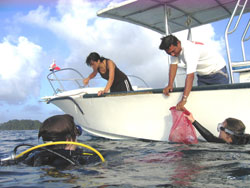Biodiversity partners link research, development and conservation
May - June, 2009 | Volume 8, Issue 3
Fogarty's International Cooperative Biodiversity Groups (ICBG) program, a cornerstone of the Center's foreign research efforts, works with U.S. grantees and private partners to find cures in nature's yet unspoiled habitats - from Fiji to Madagascar and Jordan to Panama.
As its very name implies, the International Cooperative Biodiversity Groups join U.S. government agencies with foreign counterparts, academic researchers and private partners to develop new drugs that may one day reduce the world's burden of tropical diseases, HIV, cancer, heart disease and mental illness.
Since the first awards were granted in 1993, the Fogarty-run ICBG program has operated in 22 countries and partnered with five major pharmaceutical companies: Bristol-Myers Squibb, Searle-Monsanto, Wyeth, GlaxoSmithKline and the Japanese Eisai Research Institute (ERI).

Photo by Kim Diver
Fogarty biodiversity programs collaborate with
local scientists and governments to pluck potential
cures from nature. Pictured here (from left) are
Marcy Balunas, Christina Wong, Jainer Yovanny
Ortega and Amanda Fenner, plying the waters off
Portobelo, Panama.
"They get access to the best minds in academia and to biological resources they otherwise would not," says Dr. Joshua Rosenthal, Fogarty's deputy director of international research and training and head of the biodiversity project. "At a modest cost, we act as a broker among grantees, federal agencies and the private sector and help researchers leverage our funding into much larger projects."
In the current five-year cycle, ICBG operates seven programs at about $800,000 each, a majority of the funding coming from a consortium including the National Science Foundation, the U.S. Departments of Agriculture and Energy, the National Institute of Mental Health, the National Cancer Institute, the National Center for Complementary and Alternative Medicine and the NIH Office of Dietary Supplements.
"About 40 percent of new drugs are based on what nature produces," explains Rosenthal. "Our program aims to discover these hidden substances and help in their transformation into potential cures."
The four most recent grants are for research into potential anti-cancer and mental health agents in the tropical forests of Indonesia, the study of shipworms and sea snails in the Philippines, sea- and land-based bacteria in Madagascar and the properties of micro-organisms in Panama. (See the related article on Panama Prospecting.)
Discovery, conservation, economic activity
In addition to discovery, ICBG projects in the world's biodiversity hotspots promote research training, conservation and economic development, as in Fiji, where researchers were able to show villagers how to grow coralline red algae on lava stones to sell to aquariums instead of using nonrenewable pieces of living coral.
A Fogarty-supported collaboration between the University of Papua New Guinea and the University of Utah in only five years has yielded 20 diplomas for local undergraduate and graduate students and 13 graduate and postdoctoral trainees from Utah, including two Ph.Ds. Just as important, says director Dr. Louis Barrows, is the potential for drug discovery and preservation, as well as improved health and higher incomes for local residents. "The ICBG program is an absolutely inspired, and inspirational, program," says grantee Dr. William Gerwick. "There is a very keen sense that we are doing something great in science but doing more than just science."
The ties between science and conservation and conservation and economic development are "a natural alliance," Gerwick says. "It's much more than a normal research program hopes to undertake because you have participants who come from very different walks of science and policy."
To view Adobe PDF files,
download current, free accessible plug-ins from Adobe's website.
Related Fogarty Programs